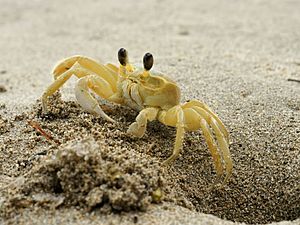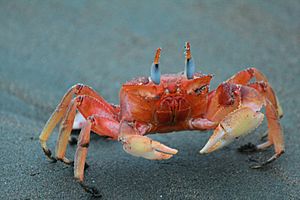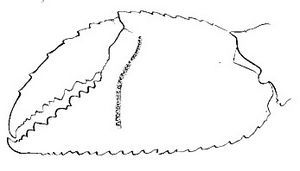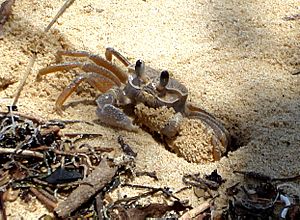Ghost crab facts for kids
Quick facts for kids Ghost crabs |
|
|---|---|
 |
|
| Ocypode quadrata | |
| Scientific classification | |
| Kingdom: | |
| Phylum: | |
| Subphylum: | |
| Class: | |
| Order: | |
| Infraorder: | |
| Family: |
Ocypodidae
|
| Genus: |
Ocypode
Weber, 1795
|
| Type species | |
| Cancer ceratophthalmus Pallas, 1772
|
|
Ghost crabs are a type of crab known for being super fast! They belong to the group called Ocypode. People often call them 'ghost crabs' because they move so quickly and blend into the sand, almost like they disappear. One of their claws is usually bigger than the other, but not as much as in male fiddler crabs.
Contents
What Do Ghost Crabs Look Like?
Most ghost crabs have pale bodies. This helps them blend in perfectly with the sand. They can even slowly change their body color to match their surroundings and the time of day. Some types, like Ocypode gaudichaudii and Ocypode ryderi, are brightly colored.
Ghost crabs have long eyestalks that stick out, with very large eyes on the bottom half. Their main body shell, called a carapace, is deep and box-shaped. It looks squarish from above. The different parts of their carapace are usually not easy to see.
Their small antennae (called antennules) fold back into their body. A wide plate sits between these antennae. The third pair of their mouth parts, called maxillipeds, completely cover their mouth. There's also a small opening with lots of hair between their second and third pairs of walking legs.
Scientists can tell different ghost crab species apart in a few ways. They look at where the crab was found. They also check if the crab has "horns" on its eyestalks. Another clue is the pattern of ridges on the inside of their larger claws. These ridges help them make sounds, a process called stridulation. For male crabs, the shape of their reproductive organs (gonopods) is also a key feature.
How Ghost Crabs Live
Homes and Breathing
Ghost crabs dig deep burrows on sandy beaches. These burrows are usually close to the ocean's edge, where the tide goes in and out. A burrow often has a long tunnel leading to a chamber at the end. Sometimes, it has a second entrance.
Ghost crabs are "semi-terrestrial," meaning they live partly on land. They breathe oxygen from the air using their moist gills. They need to keep their gills wet. They do this by getting water from damp sand or by running into the waves. But they can't stay underwater for too long, or they will drown.
What Ghost Crabs Eat
Ghost crabs are "generalists," which means they eat many different things. They are scavengers, eating dead animals and other bits found on the beach. They also hunt small animals. This includes sea turtle eggs and baby turtles, clams, and other crabs.
Daily Life and Movement
Ghost crabs are mostly active at night. During the hottest part of the day, they stay hidden in their burrows. They also stay in their burrows during the coldest parts of winter.
Ghost crabs are incredibly fast runners. If they sense danger, they dart away quickly. They either run back to their burrows or dash into the sea to escape. Their way of moving changes as they speed up. One type, O. ceratophthalma, can walk using all four pairs of legs. At faster speeds, they lift their fourth pair of legs. When they run their fastest, they use only their first and second pairs of walking legs.
Changing Colors
Ghost crabs can also change their color to match their surroundings. They do this by changing how much pigment is spread out in special cells called chromatophores. They can even match the exact color of the sand grains where they live! However, this color change is slow. It happens over a longer time, unlike some animals that can change colors very quickly.
Reproduction and Life Cycle
Ghost crabs lay their eggs in the sea. These eggs hatch into tiny larvae that float around as plankton in the ocean.
-
A horned ghost crab (Ocypode ceratophthalma) eating a baby loggerhead turtle in Gnaraloo, Western Australia. Ghost crabs are a big reason why many sea turtle eggs and babies don't survive.
Where Do Ghost Crabs Live?
Ghost crabs are common on sandy beaches in tropical and subtropical parts of the world. They are found where sandhoppers live in cooler areas. Three species live in the Atlantic Ocean and the Mediterranean Sea. Two species are found on the eastern Pacific coast of the Americas. The rest of the species live in the western Pacific and the Indian Ocean, all the way to southern Africa.
Protecting Ghost Crabs
Human activities on sandy beaches can harm ghost crabs. Things like people walking on the sand, building seawalls, or having pollution can affect them. Because ghost crabs live all over the world and their burrows are easy to count, their burrows are useful. They help scientists quickly see how much human activity is affecting beach habitats.
Images for kids
-
Atlantic ghost crab (Ocypode quadrata) coming out of its burrow in Cahuita, Costa Rica.









